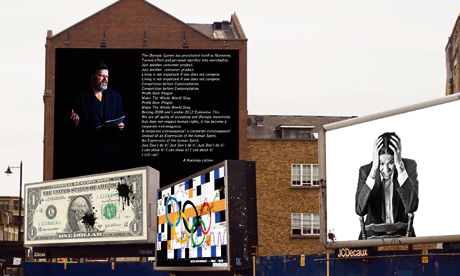Hackney galleries’ Olympic art attack

Image: Antonio Mena, at the Hundred Years Gallery (part)
The Transition Gallery looks out over a now iconic snapshot of east London: the Regent’s Canal with gas rings reflected in the water, the trendy Broadway market running a counter-current to its right, and somewhere to the left – out of site beyond Victoria Park – the grand Olympic stadium. Taking into account the grimy traces of an industrial past and tangible evidence of regeneration and gentrification, the view from up here is decidedly positive.
Indeed, Transition’s exhibition The End of the Future is the only positive vision of the Olympics I could find outside of the officially endorsed Cultural Olympiad.
Taking her inspiration from the modernist view that architecture really could change the way we live, curator Cathy Lomax really does believe that the Olympic redevelopments have made Hackney a nicer place to live. She wears her ‘Keep Hackney Crap’ badge as an ironic dig at all those cynics and disbelievers.
Yet beneath The End of the Future’s nostalgia there is still recognition of the ‘unpalatable corporate aspect’ which threatens us with the ‘broken dreams of past Utopias’.
Playing on Michael Crichton’s 1973 sci-fi film Westworld, Scare in the Community’s exhibition at Xero Kline & Coma is an utterly dystopic exploration of the corporate consumerism of the Westfield shopping complex as a symbol of Olympic development.
For curators Julika Gittner and Jon Purnell, Westfield is “a ridiculous new build with its Battenberg architecture, huge buildings designed to look like a city-scape, and its own postcode, E20.”
The feeling of disillusionment in east London is in part motivated by a fear of the unknowable Olympic legacy. In Westworld Ben Seymour’s video OLYMPICFIELD envisions the Olympic stadium of the future as an overgrown high security prison where potential WMDs are being produced.
The propaganda and conspiracy verged on hysteria at the Residence Gallery’s lecture by Dr Bill Aitchison, who believes that London 2012 signals the end of the world. One Hundred Year Gallery’s alternative opening ceremony, The Apocalympics, was similarly foreboding.
These visions are bred outside of the stadium, where those who are excluded have only rumours to feed their impressions. Cathy Lomax remembers thinking that there “would be an opportunity for small local galleries to be involved in the Cultural Olympiad, but it soon became clear that it was directed at a much higher level.”
While a group of galleries were meeting for a little while to make plans together, “this eventually dissipated.” Big names like Rachel Whiteread may have succeeded in winning a public commission, but all those works which were not officially endorsed by the Olympiad are confined to the peripheries in an exhibition of Failure at The One Hundred Years Gallery.
It is this disregard for the existing culture of east London which justifies the vehement cynicism apparent in the tone of many Hackney galleries’ dystopian vision of the Games.
East London is famous for its art scene, but the Olympics has brought in an unfamiliar, officially accredited programme of culture which masks our real identity with a public face and showcase for tourists.
The Residence Gallery’s open submission exhibition, Botany & Botulism: The Olympic Legacy Zen Garden, has found the perfect metaphor for the difficult dual nature of the Olympics. Botany represents the beauty of regrowth, and Botulism, the hidden poisons which lie beneath the surface.
Rent increases and the redevelopment of studio spaces have meant that artists have moved on, and struggling galleries and project spaces on the fringes of the Cultural Olympiad are unlikely to see the benefits of Olympic traffic.
There is a common view among artists that the Olympics are not for locals, they are a project for tourists. For Ingrid Z, Director of the Residence Gallery, the irony of the Cultural Olympiad is that a “great number of artists have been displaced by demolishing many studios and artist’s homes to make way for the Olympic Park.”
Perhaps when all of the official events are over we will find that botulism has spread. For Transition it will be the memory, the nostalgia of a golden sporting event that remains, but for many the Stadium is already a condemned wasteland.
Ingrid Z hopes that “it will be artists who ultimately save the day when loads of empty spaces emerge in Stratford,” and then the artists and galleries will reclaim Hackney.
The End of the Future
Till 12 August 2012
Transition Gallery
Unit 25a Regent Studios
8 Andrews Road, E8 4QN
Botany and Botulism: The London Legacy Zen Garden
Till 12 August 2012
Residence Gallery
229 Victoria Park Road E9 7HD
Westworld
Till 19 August 2012
Xero Kline Coma
258 Hackney Road E2 7SJ
Failure
Till 26 August 2012
Hundred Years Gallery
13 Pearson Street E2 8JD
